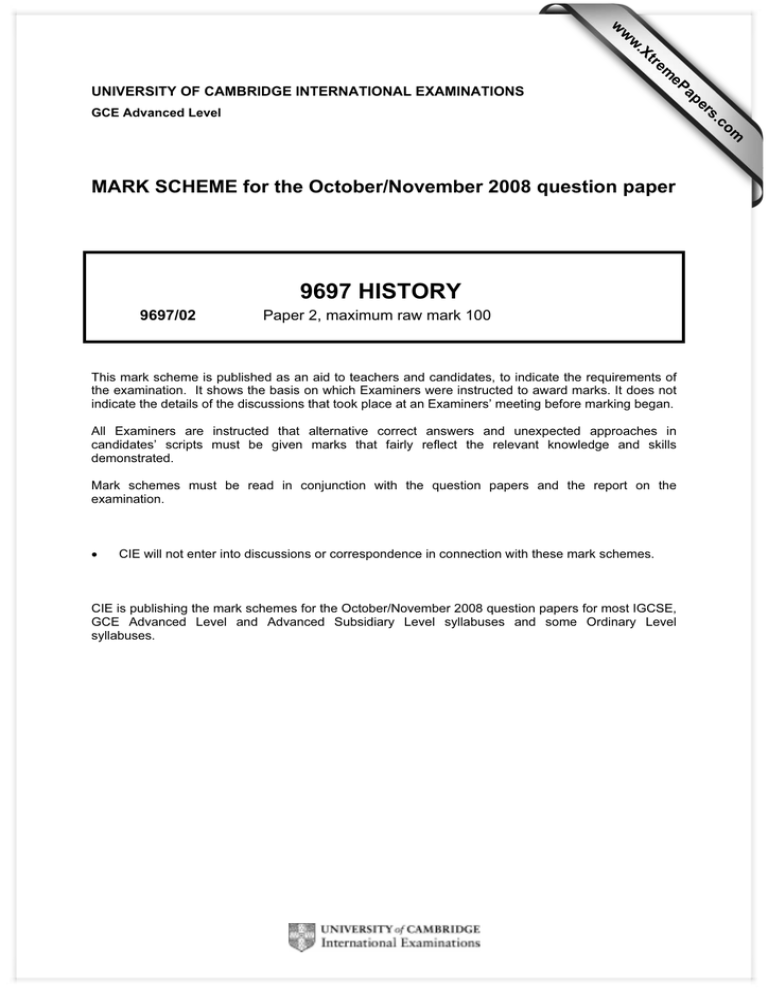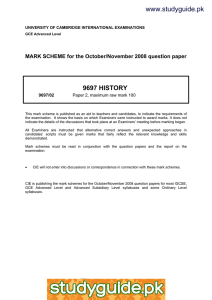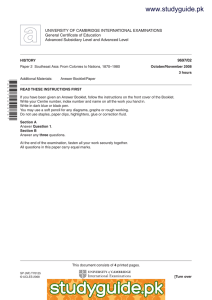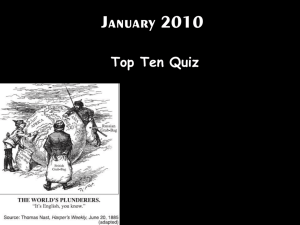9697 HISTORY MARK SCHEME for the October/November 2008 question paper
advertisement

w w ap eP m e tr .X w UNIVERSITY OF CAMBRIDGE INTERNATIONAL EXAMINATIONS s er om .c GCE Advanced Level MARK SCHEME for the October/November 2008 question paper 9697 HISTORY 9697/02 Paper 2, maximum raw mark 100 This mark scheme is published as an aid to teachers and candidates, to indicate the requirements of the examination. It shows the basis on which Examiners were instructed to award marks. It does not indicate the details of the discussions that took place at an Examiners’ meeting before marking began. All Examiners are instructed that alternative correct answers and unexpected approaches in candidates’ scripts must be given marks that fairly reflect the relevant knowledge and skills demonstrated. Mark schemes must be read in conjunction with the question papers and the report on the examination. • CIE will not enter into discussions or correspondence in connection with these mark schemes. CIE is publishing the mark schemes for the October/November 2008 question papers for most IGCSE, GCE Advanced Level and Advanced Subsidiary Level syllabuses and some Ordinary Level syllabuses. Page 2 Mark Scheme GCE A LEVEL – October/November 2008 Syllabus 9697 Paper 02 Generic mark bands for essay questions Examiners will assess which Level of Response best reflects most of the answer. An answer will not be required to demonstrate all of the descriptions in a particular Level to qualify for a Mark Band. Band Marks Levels of Response 1 21–25 The approach will be consistently analytical or explanatory rather than descriptive or narrative. Essays will be fully relevant. The argument will be structured coherently and supported by very appropriate factual material and ideas. The writing will be accurate. At the lower end of the band, there may be some weaker sections but the overall quality will show that the candidate is in control of the argument. The best answers must be awarded 25 marks. 2 18–20 Essays will be focused clearly on the demands of the question but there will be some unevenness. The approach will be mostly analytical or explanatory rather than descriptive or narrative. The answer will be mostly relevant. Most of the argument will be structured coherently and supported by largely accurate factual material. The impression will be that a good solid answer has been provided. 3 16–17 Essays will reflect a clear understanding of the question and a fair attempt to provide an argument and factual knowledge to answer it. The approach will contain analysis or explanation but there may be some heavily descriptive or narrative passages. The answer will be largely relevant. Essays will achieve a genuine argument but may lack balance and depth in factual knowledge. Most of the answer will be structured satisfactorily but some parts may lack full coherence. 4 14–15 Essays will indicate attempts to argue relevantly although often implicitly. The approach will depend more on some heavily descriptive or narrative passages than on analysis or explanation, which may be limited to introductions and conclusions. Factual material, sometimes very full, will be used to impart information or describe events rather than to address directly the requirements of the question. The structure of the argument could be organised more effectively. 5 11–13 Essays will offer some appropriate elements but there will be little attempt generally to link factual material to the requirements of the question. The approach will lack analysis and the quality of the description or narrative, although sufficiently accurate and relevant to the topic if not the particular question, will not be linked effectively to the argument. The structure will show weaknesses and the treatment of topics within the answer will be unbalanced. 6 8–10 Essays will not be properly focused on the requirements of the question. There may be many unsupported assertions and commentaries that lack sufficient factual support. The argument may be of limited relevance to the topic and there may be confusion about the implications of the question. 7 0–7 Essays will be characterised by significant irrelevance or arguments that do not begin to make significant points. The answers may be largely fragmentary and incoherent. Marks at the bottom of this Band will be given very rarely because even the most wayward and fragmentary answers usually make at least a few valid points. © UCLES 2008 Page 3 Mark Scheme GCE A LEVEL – October/November 2008 Syllabus 9697 Paper 02 Note: all papers are to be marked using the generic marking bands for source-based and essay questions. Section A: The political development of Singapore, 1945–65 1 ‘There was never any real prospect of the Communists taking over the PAP’. How far do sources A–D support this statement? CONTENT ANALYSIS L2–3 EVALUATION A Secondary view from a PAP publication, Produced in 1979. Highlights view – organisation of Communists and their ability to withstand British oppression suggests they had a chance of success. N X Ref with B. B View from Singapore PM Produced in 1968. Suggests possibility of a takeover had Tun Lim Yew Hock not arrested half of PAP Committee. Y X ref with A and E. Views to PAP sources who may wish to justify events. C Academic study produced in 1990s. Takes view there was a possibility in 1957 when Communists packed PAP conference. Y D Memoir of a PAP activist published in 1990s. View suggests there was possibility of a takeover. Communists were wiling to use rough tactics and had infiltrated the trade union movement. Y X Ref with A and B. View by academic who is writing many years after event. Able to view events from historical and academic perspective. X ref with A and B. Personal view which corroborates other personal PAP views in A and B. © UCLES 2008 L4–5 Source suggests that Communists might have had a chance but doesn’t state clearly that Communists would take over the PAP. Takes a balanced view stating that there might have been a chance but also states that Lee would never be a tool of the Communists. Therefore, takeover unlikely. Takes view that fate intervened suggesting there was a possibility of a Communist takeover. Y/N View written decades after the event and has benefit of hindsight. Suggests a real prospect of taking over PAP. Y Y/N Y/N Page 4 Mark Scheme GCE A LEVEL – October/November 2008 Syllabus 9697 L1 WRITES ABOUT THE HYPOTHESIS, NO VALID USE OF SOURCES. Paper 02 [1–5] These answers will be about the inclusion of Communists in the PAP, and the upper band will discuss British responses to the Communists during the period. These answers will ignore the question i.e. they will not use the sources as information/evidence to test the given hypothesis. Include in this level answers which give information taken from the sources, but only producing an account of events rather than exploring the hypothesis. L2 USES INFORMATION TAKEN FROM THE SOURCES TO CHALLENGE OR SUPPORT THE HYPOTHESIS. [6–8] These answers use the sources as information rather than evidence, i.e. sources are used at face value only with no evaluation /interpretation of context. e.g. ‘Yes. Source A indicates that the PAP needed Communist backing and Source D indicates that the Communists were much stronger than the PAP, meaning that within the Party they could have taken over.’ L3 USES INFORMATION FROM SOURCES TO CHALLENGE AND SUPPORT THE HYPOTHESIS. [9–13] These answers know that testing the hypothesis involves both attempting to confirm or to challenge it. However, sources are still used only at face value. e.g. ‘There is evidence for and against the view that the Communists threatened to take over the PAP. Source A describes how the communists were more active members of the party, and so more willing to take decisive action, and that the early PAP lacked such figures. Source D though shows how the PAP used constitutional methods which did not need the communist activism so in this sense the communists were incompatible with the PAP.’' L4 BY INTERPRETING/EVALUATING SOURCES IN CONTEXT, FINDS EVIDENCE TO CHALLENGE OR SUPPORT THE HYPOTHESIS. [14–16] These answers are capable of using sources as evidence, i.e. demonstrating their utility in testing the hypothesis by interpreting them in historical context rather than simply accepting them at face value (as in L3) e.g. ‘Source C, the only extract taken from an objective history, indicates that the procommunists sought to take over the PAP. The other sources are from particular perspectives which mean that they are not as objective as Source C. Source B for instance etc...’ © UCLES 2008 Page 5 Mark Scheme GCE A LEVEL – October/November 2008 Syllabus 9697 Paper 02 L5 BY INTERPRETING/EVALUATING SOURCES IN CONTEXT. FINDS EVIDENCE TO CHALLENGE AND SUPPORT THE HYPOTHESIS. [17–21] These answers know that testing the hypothesis involves attempting both to confirm and challenge the hypothesis, and are capable of using sources as evidence to do this (i.e. both confirmation and challenge are done at this level). e.g. ‘Source C, the only extract taken from an objective history, indicates that the procommunists sought to take over the PAP. Source B indicates that the PAP were prepared to arrest the communists so were powerful enough to combat their influence. On the other hand, in reflecting upon the early years of the party, Lee does admit that the party was not strong enough without the communists. He knew this personally because he saw the lack of activism among early members compared to the tough tactics of the Communists, and it does seem that they posed a threat to both the colonial authorities and the PAP.’ L6 AS L5 PLUS EITHER (a) EXPLAINS WHY EVIDENCE TO CHALLENGE/SUPPORT IS BETTER/ PREFERRED, OR (b) RECONCILES/EXPLAINS PROBLEMS IN EVIDENCE TO SHOW THAT NEITHER CHALLENGE NOR SUPPORT IS TO BE PREFERRED. [22–25] For (a) this builds upon L4 and L5, but the argument must be that the evidence for challenging/supporting is better/preferred. This must involve a comparative judgement i.e. not just why some evidence is better, but why other evidence is worse. e.g. ‘The evidence to suggest that the PAP were weaker than the Communists in the early period of the Party and did pose a threat from within. This evidence comes directly from those within the PAP. It is an admission that in the early days of the movement it was weak and vulnerable, and that the Communists were by far the more important party. In addition, Sources A, C and D are mutually complimentary, showing that the PAP perspectives do not contradict one another.’ For (b) include all L5 answers whilst using the evidence to present a nuanced response which may modify the hypothesis (rather than simply seeking to support/contradict) in order to improve it. e.g. ‘The sources have to be examined according to their context. Sources A and D examine the early period development of the PAP, when clearly the party was weak and needed communist support in pursuit of its goals. At this stage, it was vulnerable to Communist takeover from within. Sources B and C on the other hand deal with a period when the party had developed and could therefore deal with the Communist threat from within, getting rid of communists and showing that they were no longer needed Therefore, in the early development of the PAP, the party was vulnerable, but as the Party developed, it was able to resist a communist take-over.’ For highest level in both (a) and (b). the conclusion should be based on an overall assessment of the different opinions/perceptions shown in the sources or by establishing different criteria for support/contradiction. © UCLES 2008 Page 6 Mark Scheme GCE A LEVEL – October/November 2008 Syllabus 9697 Paper 02 Section B 2 ‘In economic terms, Asian peoples were better off under colonial domination than they had been before.’ How far do you agree with this judgement? Students should discuss whether the penetration of Western economic conditions brought greater prosperity than pre-colonial economies. They should examine in particular factors such as the stability of pre-colonial economies, compared with the de-stabilising effects of capitalism, contrasted with the potential benefits the later might have brought. The opinion in the quote tends to have been put forward by colonialists themselves, who viewed traditional economies as ‘backward', making the penetration of capitalism necessarily ‘progressive’. Pre-colonial economies were based around villages and production was of subsistence for the village as an isolated unit. The main forms of economic activity were smallscale agriculture and handicrafts. There was little money in circulation, nor little need for it. The risks of this system were bad harvests, war, or disease, all of which could potentially halt all activity. Farming continued under colonial regimes but became large scale, and credit based, Burmese rice farming being one example of this. The risks of this were the loss of land against loans. The benefits were a cash economy which diversified the economy, and, if managed well, could be used to cover times of natural disaster or bad harvest. In French Indo-China, land was requisitioned by the French authorities in order to establish large scale farming, thus making the population dependent upon the regime for their subsistence. Colonial regimes did encourage better economic conditions among indigenous populations in certain cases. In the Dutch East Indies for example, the ‘ethical' imperialism, meant a focus on raising living standards. This was though backed by a desire for indigenous peoples to become greater consumers as a consequence. In terms of labour for large scale industrial interests, colonial regimes initially conscripted indigenous labour which was placed under harsh economic and social conditions. Eventually though, labour was gained as a result of migrating populations, especially to rubber plantations of Cochin China and Cambodia. This had a mixed economic effect. Although the living conditions of newly employed labourers were hard, and they were cut-off from their traditional communities, the wealth incentive in terms of pay was high. 3 Why was it that colonial regimes encouraged the development of plural societies? Candidates will examine the relationship between socio-economic pluralism and ethnic pluralism in colonial societies. Candidates should observe that ethnic pluralism was a material consequence of the artificial boundaries imposed by the colonial powers, and the subsequent greater inter-and intra societal migrations of peoples under colonial regimes. Stronger candidates will trace how that type of pluralism was affected by on-going socio-economic changes, such as the development of education, and of indigenous administrative classes. In Burma, a western educated administration created a new social milieu in society which challenged the authority of traditional leaders whilst appealing to certain traditional values, especially Buddhism. They implemented policies which focused on a national, rather than local level. In both Malaya and the Dutch East Indies, both comprising of smaller (former) states, socioeconomic changes were inter-cut with ethnic differences. These were plural societies when they were formed, because they were formed by bringing together multiple societies. In French Indochina, Indonesia and Malaya, communists emphasised class antagonism, but adapted the theory to include the struggle of the peasantry, the workers and other indigenous groups against colonial powers. In this sense, they were confronted by, and tried to address the complex pluralism of colonial societies. This was most successful in Indochina, where the causes of communism and nationalism became virtually inseparable. In Indonesia, the communists were less successful in addressing this issue. © UCLES 2008 Page 7 4 Mark Scheme GCE A LEVEL – October/November 2008 Syllabus 9697 Paper 02 How far did the Japanese achieve their aim of a ‘Greater East Asia Co-Prosperity Sphere’ from 1941 to 1945? Candidates should examine the political and economic structures put in place by the Japanese and question the extent to which these were co-operative, rather than coercive. The term ‘co-prosperity' refers to the ‘Greater East Asia Co-Prosperity Sphere' – an idea which took shape in Japan during the 1930s, and was used by the Japanese to explain their intentions towards their newly-acquired empire in Southeast Asia. Initially, Japan did not establish any mechanism of co-prosperity as its central concern was securing its vast newly acquired empire. In addition, there was a great difference in the state of the economies of the territories conquered by Japan; French-Indochina, Malaya, Thailand, Burma, Borneo, and the Dutch East Indies, and the advanced Japanese economy. These territories were resource-rich whereas the Japanese economy was manufacture-based, suggesting a pillage of resources by Japan. In some cases, the Japanese promoted indigenous regimes to the level of partnership, by recognising their independence, most notably in Indonesia. Yet this came too late in the war to see its exercise in practice. In Indo-China, the remnants of the old colonial power remained in place under the auspices of Vichy rule. In Burma, co-operation did occur between indigenous politicians (Ba Maw and others) and the Japanese, but the Burmese population was still treated coercively by the Japanese, with conscription into work schemes a being notable example. In the Philippines, an indigenous committee was established to exploit the former administration as much as possible. The Japanese did not attempt further industrialisation of any of these territories, focusing on primary resource exploitation, so in this sense little changed from the colonial regimes. The high level of export to Japan brought little currency benefit, with Japan paid in yen credits to Japanese banks, which these territories could not access. They did focus on agricultural self-sufficiency as a means of maintaining stability. Towards the end of the war, with Japanese shipping almost entirely unable to function, the economies of these territories were isolated and decaying, with little economic activity at all. 5 How effectively did colonial governments respond to the rise of Nationalism in Southeast Asia up to World War Two? Stronger candidates might question whether the responses of colonial governments weren't in fact insignificant in the long-run, given the consequences of the Second World War. Early Indonesian nationalism, especially that which was also influenced by communism, was radical and pursued its objectives through direct action. The Dutch colonial government responded using force to destroy the infrastructure of nationalist parties. By the end of the Second World War, the nationalists had gained administrative control of Indonesia and the Dutch 'police action' was ineffective. In this case the reactions of the colonial government were relatively insignificant to the achievement or otherwise of independence, which came as a consequence of the Japanese occupation. In Indochina, as with Indonesia, an early nationalist uprising was quashed. In this case, nationalism became more communistic as a response. In the end, this change would have dire consequences for French re-colonisation after the war, as the communists proved more tactically adept then the early nationalists. In Malaya, the British did not face a nationalist party, but rather pressure from indigenous rulers of the Malay states for greater independence for the states from the central colonial administration. In Burma, nationalist pressure came not just from within, but also from without, especially the nationalist movement in India. The double effect of this was that the British gave Burma formal independence from India in the 1930s, as well as establishing a representative form of indigenous administration. © UCLES 2008 Page 8 6 Mark Scheme GCE A LEVEL – October/November 2008 Syllabus 9697 Paper 02 Examine the influence of the superpowers over decolonisation in Southeast Asia after World War Two. (You must not use examples drawn from Singapore to support your answer.) Candidates should examine the extent of superpower influence in the wake of the Second World War. They may question whether, at the war's end, the superpowers weren't more prepared to let certain situations resolve themselves, rather than directly intervening. They should also examine why superpower influence differed over different territories, with some gaining independence as a result of superpower policies, whilst in other cases such policies had little effect. Roosevelt had been strongly opposed to the reinstallation of colonial regimes in the post-war period, advocating a trustee system to guide former colonies to independence at the war's end. Truman though quickly reversed this decision, and even before the end of the war allowed the French to prepare for an intervention in Indochina, which they carried out in 1946. Laos profited from this policy in particular, with the French recognising their independent status whilst fighting to retain Vietnam. In the immediate aftermath of the war, the United States and her allies were most concerned with their ability to reform administrations. In the case of Indonesia, the consequence of this policy was that the indigenous regime which had been recognised by the Japanese continued to rule in the post war period. This with the exception of the outer islands, where the Japanese had been replaced by the Australians, rather than an indigenous administration. These islands offered a door-step back into Indonesia for the Dutch in their attempts to retake control of Indonesia in the post war period. In the end, pressure from the United States upon the Dutch, who relied on US Marshall Aid to rebuild the home territory, forced the Dutch to withdraw. The British in Malaya managed to stave off explicit superpower intervention by demonstrating an ability to act as a trustee towards Malay Union, whilst at the same time securing their interests in the region. It should be noted that Cold War tensions in Southeast Asia only escalated towards the end of the 1940s, with renewed civil war in China, as well as foreign aid packages from both superpowers. In essence then, in the wake of the war, although in some cases superpower intervention was important, it was limited, becoming more explicit in the 1950s and 1960s. 7 How far has it been state participation that has determined economic success or failure in newly-independent Southeast Asian States? (You may refer to Thailand in your answer). Candidates will explore the level of state intervention in the different territories of Southeast Asia and assess whether state intervention has helped or hindered economic growth. Stronger candidates will explore the different contexts, and may link the level and nature of state intervention to the political nature of the states. Candidates may consider strategies used by governments to promote economic development. Domestic instability in Burma has been caused by restrictive government economic policies, particularly with regard to the rice trade. In this case, government intervention takes the form of rules and controls, rather than government spending to increase growth. In Laos, a highly controlled economy grew little, and even when it tried to liberalise in the 1980s there was little consequent economic growth, resulting eventually in a policy reversal back to state intervention. Here, state involvement in the economy has reflected a more widespread state intervention into the Burmese society since independence. Singapore enjoyed little government intervention and a free market encouraging foreign investment. This in turn has contributed considerably to a stable society. Government intervention was catastrophic in Cambodia after Khmer Rouge victory. Modem industry was shut down, and industrial workers forcedly repatriated to the countryside. This intervention in the economy was based upon a political, rather than economic vision- which is why it was such a failure. © UCLES 2008 Page 9 8 Mark Scheme GCE A LEVEL – October/November 2008 Syllabus 9697 Paper 02 Assess the causes of rivalry and conflict between the newly-independent states of Southeast Asia. (You may refer to Thailand in your answer). Candidates should examine a range of disputes to explore whether there is any common or regional causality. They may explore factors such as the colonial legacy, ethnic tensions, and resource exploitation. Stronger candidates may explore how much the establishment of regionalism, especially ASEAN, has resolved these disputes. Malaysia-Philippines dispute over Sabah. This dispute is based upon the colonial inheritance of the region, with Sabah gaining independence from the British but joining Malaysia. The claim of the Philippines rests on the argument that the land was originally leased to the colonial powers in the nineteenth century (like Hong Kong) and therefore should have been released back to them. The Malaysia-Indonesia dispute over the Sipadan and Ligitan Islands was largely due to competition for oil in the region which is most certainly a modem reason. However, the traditional aspect of the conflict is that these islands were uninhabited, and therefore traditional claims were weak. The other reason was that they were based on agreements between the colonial powers, not the indigenous peoples of the area. Border disputes between Thailand and Burma have been largely caused by the presence of ethnic minorities, rather than any territorial claim but the invasion of Cambodia by Vietnam was for political regime change, rather than territorial gain. © UCLES 2008







